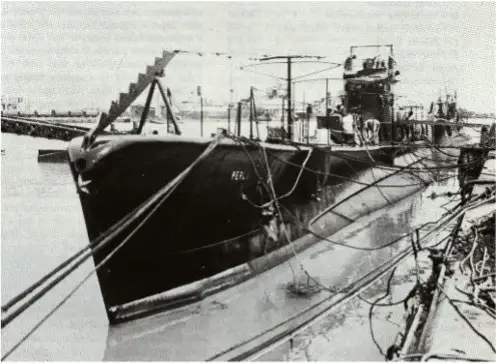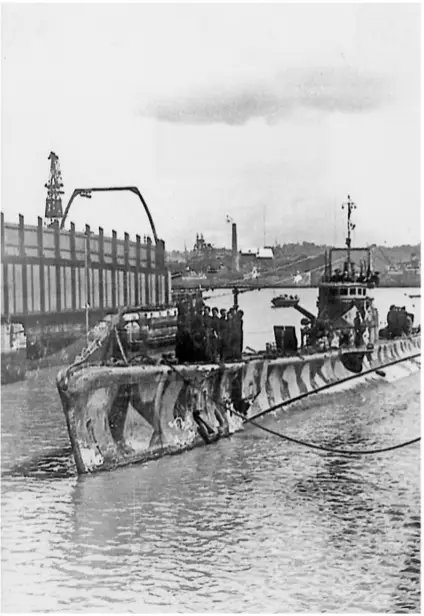Background

Figure 1 The Perla in with its original pre-war color scheme
The Perla was an Italian submarine belonging to the “600” class, type Perla, launched in 1936. These types of submarines deployed by the Regia Marina were suited for operations in the Mediterranean, due to their smaller size and autonomy, bigger submarines (Like the Marconi or Marcello class) were used for operations in the Atlantic or Indian ocean.
At the outbreak of world war two, the Perla is deployed in the Eritrean base of Massawa, forming the 8th submarine group, together with the subs Guglielmotti, Galileo Ferraris, Galileo Galilei, Luigi Galvani, Maccallè, Archimede and Torricelli. The vessel is placed under the command of lieutenant Pouchain.
Early actions in the Red sea
Soon after the Italian entry into the war, on the 18th June 1940, commander Pouchain is ordered to depart from Massawa and deploy the Perla in the Gulf of Tadjoura, off the coast of Djibouti, to search for enemy ships. Already at the beginning of the voyage, the air conditioning system failed to function correctly, provoking the sharp increase of temperature inside the submarine, probably reaching 60°. The commander then ordered to disassemble the system for repairs, but he could not be aware of the threat hidden there. The air conditioning systems of the 600 class made use of toxic gas, the methylene chloride, in case of leaking or disassembling, the gas could have proved extremely dangerous for the crew. Unaware of the threat, the crew started to breathe the toxic gas released by the disassembled air conditioning system.
On the 23rd of June, the Perla reached its destination, but more and more crew members showed signs of intoxication, like madness and violent behaviours. With no enemy vessels sighted, the mission was soon aborted, and the Perla made the route to Massawa. In the following days, the situation on board deteriorated, several crew members showed signs of madness. To maintain control, they were locked down in the forward torpedo compartment. On the 26th, commander Pouchain decided to emerge and allow the crew to breathe some fresh air, given the detrimental situation on board. Soon after, they spotted a British warship, the sloop HMS Shoreham. The Perla submerged once again to escape the enemy vessel that chased the Italian submarine for a couple of hours and damaging it with depth charges. The Perla miraculously escaped and emerged again when sighting the Eritrean coast. At this point, the Perla incurred into unmarked shallow waters that caused the submarine to run aground.
Pouchain sent a distress message to the navy command in Massawa who dispatched a couple of destroyers to aid the Perla. The rescue mission was called off almost immediately when a superior British formation was sighted nearby. HMS Kingston was detached in search of the damaged Perla that finally appeared on the horizon. Commander Pochain ordered his crew to abandon the ship while he coordinated the gunfire of Perla’s deck gun against the approaching Kingston that also fired back. After firing two shots, the deck gun jammed, and the fate of the Perla seemed to be sealed. At the last moment, a formation of S.M.81 bombers appeared in the sky and attacked the Kingston, forcing its retreat and saving the Perla. In the next hours, the surviving crew was rescued by destroyer Daniele Manin and Perla was then towed back to Massawa on the 20th of July.
The great escape

Figure 2 The voyage of the Italian submarines
The repairs on the Perla took time and efforts in the poorly supplied base of Massawa so the unit never returned in service before early 1941. In February 1941, the situation in East Africa was deteriorating for the Italians and soon the Regia Marina decided to evacuate the last four surviving submarines. The plan was to leave Massawa and head for the base of Bordeaux in occupied France, with an intermediate rendezvous with a German supply ship in southern Atlantic. Guglielmotti, Archimede and Galileo Ferraris were designed for oceanic operations and this kind of voyage laid within their possibilities. The plan was much harder to execute for the Perla, a submarine not suited for a long voyage nor oceanic operations. Nevertheless, the Perla left Massawa on the 1st of March 1941, under the new commander Bruno Napp, who was instructed to make two rendezvous with German supply ships, given the much more limited autonomy of his sub.

Figure 3 The Perla arriving in Bordeaux.
Once entered the Indian ocean, the Perla was subject to much more rough sea conditions but managed to cruise undisturbed east of Madagascar and more to the south linked up with the first German supply ship. This one proved to be the famous auxiliary cruiser Atlantis, commanded by Bernhardt Rogge, who could not believe in the impossible mission of the small Italian submarine. Rogge met Napp and expressed to him his doubts on Perla’s success chances of reaching Bordeaux, he also advised Napp to set a course for Brazil or Argentina. Allegedly, the Italian commander replied asking Rogge to concede him a warm shower, then he would have done the impossible to lead his men home. The German crew re-supplied and assisted the Italians at the best of their abilities, then the Perla carried on its mission. After other 4000 nautical miles, the Perla linked up with the second German ship, the Northmark, in Southern Atlantic. The voyage continued with no sighting of enemy ships and, after 81 days at sea and 13.100 nautical miles covered, the little Perla finally entered the base of Bordeaux on the 20th May 1941, welcomed by the cheerful crews of the other Italian submarines, safely arrived in the base.
Epilogue
In October, the Perla was re-deployed to the Mediterranean, taking part in several “ambush” missions but scoring no relevant successes. On the 9th of July 1942, while patrolling the waters off Beirut (Lebanon), the Perla spotted the British corvette HMS Hyacinth and launched two torpedoes. The corvette managed to avoid the torpedoes and attacked the Perla with an intense launch of depth charges. Seriously damaged, the submarine emerged while the Captain ordered the crew to abandon the ship and prepared to scuttle the vessel. Due to the failure in opening some air vents, damaged in the fight, the Perla sunk too slowly. This allowed some men of HMS Hyacinth to get on board and stop the sinking. The Perla is thus captured and towed to Beirut where the British renamed it P.712. In 1943 the submarine was handed over to the Greek Navy and renamed Matrozos, remaining in service until 1954.
Along its incredible service career, the Perla truly (and surprisingly) demonstrated its refusal to sink, sparing the lives of all the men who served on board it.
Sources:
Giorgerini, G. (1994). Uomini sul fondo.
